Experimental Study of the Heat Flow and Energy Consumption during Liquid Cooling Due to Radiative Heat Transfer in Winter
Abstract
:1. Introduction
2. Materials and Methods
2.1. Experimental Refrigeration Unit
2.2. Method for Experimental Measurement of Heat Flux in a Radiator
2.3. Theoretical Calculation of Heat Flux in the Radiator
2.4. Characteristics of a Radiator with Increased Thermal Conductivity
2.5. Weather Data
3. Results of Experiments and Discussion
3.1. Heat Flow Calculation Results
3.2. Comparison of Experimental and Theoretical Data
3.3. The Influence of Snow on the Operation of the Radiator
3.4. Estimation of the Maximum Possible Amount of Heat Transerred by the Radiator
3.5. Experimental Specific Energy Consumption for Heat Dissipation
3.6. Conditions for Switching on RC Instead of a Vapor Compression Refrigeration Machine (Chiller)
4. Conclusions
- Experimental studies of a radiator integrated into the roof have shown that, in winter in a continental climate, it can discharge from 20 ± 6.8 to 80 ± 8 W·m−2 at temperature difference changes from 5 to 15 °C. Due to the removal of heat from both sides of the radiating surface, the heat transfer coefficient of the radiator reached 5.6 ± 1.4 W·m−2·K−1. An analysis of the results showed that the theoretical method used for calculating heat transfer processes in the radiator was applicable in the winter period, since it showed satisfactory agreement with the experimental data. A theoretical calculation showed that, in winter, the heat flux removed by the radiator will be 15% less than the heat flux in summer. The same theoretical methods can be used in the warm season. When heat was removed from both sides of the radiating plate of the radiator, precipitation in the form of snow did not cause a significant decrease in the heat flux.A steel surface coated with zinc oxide is an acceptable coating for a nonselective radiator. In wintertime, ice and snow accumulate on the radiating surface. Because of this, its optical properties will have little effect on the process of heat removal. However, the investigated construction of the radiator is not optimal, since it has a relatively low heat transfer coefficient. The rejected heat flux can be increased more than twice by increasing the thermal conductivity of the radiating plate. The radiator design studied in this work should not be used. However, a radiator with increased thermal conductivity can be applied. The proposed design cannot be used to obtain temperatures below the ambient air temperature. At the same time, it allows to minimize the cost of 1 m2 of the radiating surface.Even when using a radiator with increased thermal conductivity, the heat flow will not exceed 51% of the maximum possible theoretical value.In the presented work, the effect of wind on the operation of the radiator was not taken into account, which can be significant when placing the radiator on the roof of a building. The operation of the radiator during the daytime has not been studied.
- The amount of heat transferred per watt of electrical power of a refrigeration unit with radiative and convective cooling of the heat transfer liquid has been estimated. It varied from 0 to 8 W·W−1 at a temperature difference from 0 to 15 °C. The investigated experimental refrigeration unit will be more efficient than a traditional vapor compression chiller, provided that the heat transfer liquid temperature is 6 °C higher than the ambient air temperature. When this condition is met, the radiator can be turned on. The use of a radiator with increased thermal conductivity of the radiating plate could increase the amount of heat transferred per watt of electrical power to 9–22.5 W·W−1 at a temperature difference of 5 to 15 °C. This result shows that RC can be used in winter instead of a vapor compression chiller.The results of the work can be used in the development of refrigeration systems with natural or radiative cooling of the heat transfer liquid used in winter to maintain the temperature in food storage chambers. Data on the dependence of the heat flow and energy efficiency can be used in the development of control schemes of such systems.Additionally, the results of this work can be indirectly used in the study of the thermal balance of engineering structures in winter conditions.A more detailed study of the effect of ice on the radiating surface of the radiator under an infrared radiation flux should be accomplished. Additionally, attention should be paid to reducing the energy consumption for the circulation of the heat transfer liquid. In further works, the possibility of cooling the air in radiators in winter should also be feasible. Conducting these studies can be aimed at comparing the advantages and disadvantages of using RC in comparison with traditional free cooling due to convection.
Author Contributions
Funding
Data Availability Statement
Conflicts of Interest
Nomenclature
| Arad | radiator area (m2) |
| c | heat capacity (J·kg−1·K−1) |
| COP | coefficient of performance (W·W−1) |
| krad | overall heat transfer coefficient (W·m−2·K−1) |
| m | mass (kg) |
| Np | power consumption of the pump (W) |
| t | temperature (°C) |
| tdew | dew temperature (°C) |
| trad | temperature of the radiating surface (°C) |
| Δtrad | average temperature difference on the radiator (°C) |
| Tsky | assumptive sky temperature (K) |
| υair | wind speed (m·s−1) |
| Qsum | total heat power rejected by the radiator (W) |
| Qp | heat power released by the pump (W) |
| Qw | heat power gained through the wall of the cold accumulator (W) |
| q | heat flux (W·m−2) |
| qconv.up, qconv.down | convective heat flux from upper and under sides of plate (W·m−2) |
| qrad.up, qrad.down | infrared heat flux from upper and under sides of plate (W·m−2) |
| qsum | total heat flux from radiator (W·m−2) |
| qsum.t.max | total maximum possible theoretical heat flux from radiator (W·m−2) |
| Vn | nominal flow, m3·hour−1 |
| εrad | relative emissivity of surface |
| η | efficiency of radiator |
| σ | Stefan-Boltzmann constant 5.67·10−8 (W·m−2·K−4) |
| γ | angel of contact of tube by plate (°) |
| τ | duration of time interval between measurements (s) |
| Subscript | |
| 1 | at the beginning of the period |
| 2 | at the end of period |
| air | ambient air |
| conv | convective |
| e | experimental value |
| med | average value for period of time |
| htl | heat transfer liquid in cold accumulator |
| rad | radiative |
| rc | radiative cooling |
| rm | refrigeration machine |
| t | theoretical value |
References
- Coulomb, D.; Dupon, J.-L.; Pichard, A. The Role of Refrigeration in the Global Economy: 29th Informatory Note on Refrigeration Technologies; International Institute of Refrigeration: Paris, France, 2015. [Google Scholar]
- Scarlat, N.; Prussi, M.; Padella, M. Quantification of the carbon intensity of electricity produced and used in Europe. Appl. Energy 2022, 305, 117901. [Google Scholar] [CrossRef]
- Suhendri; Hu, M.; Su, Y.; Darkwa, J.; Riffat, S. Implementation of passive radiative cooling technology in buildings: A review. Buildings 2020, 10, 215. [Google Scholar] [CrossRef]
- Li, H.; Zhang, K.; Shi, Z.; Jiang, K.; Wu, B.; Ye, P. Cooling benefit of implementing radiative cooling on a city-scale. Renew. Energy 2023, 212, 372–381. [Google Scholar] [CrossRef]
- Zhao, B.; Hu, M.; Ao, X.; Chen, N.; Pei, G. Radiative cooling: A review of fundamentals, materials, applications, and prospects. Appl. Energy 2019, 236, 489–513. [Google Scholar] [CrossRef]
- Mulik, P.V.; Kapale, U.C.; Kamble, G.S. Comparative study of experimental and theoretical evaluation of nocturnal cooling system for room cooling for clear and cloudy sky climate. Glob. Chall. 2019, 3, 1900008. [Google Scholar] [CrossRef] [PubMed] [Green Version]
- Taylor, S.; Long, L.; McBurney, R.; Sabbaghi, P.; Chao, J.; Wang, L. Spectrally-selective vanadium dioxide based tunable metafilm emitter for dynamic radiative cooling. Sol. Energy Mater. Sol. Cells 2020, 217, 110739. [Google Scholar] [CrossRef]
- Goldstein, E.A.; Raman, A.P.; Fan, S. Sub-ambient non-evaporative fluid cooling with the sky. Nat. Energy 2017, 2, 17143. [Google Scholar] [CrossRef]
- Meng, F.; Zhang, Q.; Lin, Y.; Zou, S.; Fu, J.; Liu, B.; Wang, W.; Ma, X.; Du, S. Field study on the performance of a thermosyphon and mechanical refrigeration hybrid cooling system in a 5G telecommunication base station. Energy 2022, 252, 123744. [Google Scholar] [CrossRef]
- Karagusov, V.I.; Goshlya, R.Y.; Serdyuk, V.S.; Kolpakov, I.S.; Nemykin, V.A.; Pogulyaev, V.I. Experimental stand for investigation of the radiation life—Support systems: First experiments. AIP Conf. Proc. 2018, 2007, 030014. [Google Scholar]
- Karagusov, V.I.; Serdyuk, V.S.; Kolpakov, I.S.; Nemykin, V.A.; Pogulyaev, V.I. Experimental determination of rate and direction of heat flow of the radiation life—Support system with vacuum heat insulation. AIP Conf. Proc. 2018, 2007, 030015. [Google Scholar]
- Tsoy, A.P.; Granovskiy, A.S.; Baranenko, A.V.; Tsoy, D.A. Effectiveness of a night radiative cooling system in different geographical latitudes. AIP Conf. Proc. 2017, 1876, 020060. [Google Scholar]
- Fält, M.; Zevenhoven, R. Radiative cooling in northern Europe for the production of freezer temperatures. In Proceedings of the 23rd International Conference on Efficiency, Cost, Optimization, Simulation, and Environmental Impact of Energy Systems, ECOS 2010, Coupole, France, 14 June 2010; pp. 413–419. [Google Scholar]
- Tsoy, A.P.; Alimkeshova, A.K.; Granovskiy, A.S. Cooling process modeling of a periodically incoming liquid, using night radiation cooling. AIP Conf. Proc. 2018, 2007, 030066. [Google Scholar]
- Yang, H.; Hu, Z.; Ge, F.; Liu, X. Analysis of cooling performance and energy consumption of nocturnal radiation and natural ventilation combined mechanical refrigeration system for outdoor prefabricated substation. Appl. Therm. Eng. 2023, 230 Pt A, 120650. [Google Scholar] [CrossRef]
- Tsoy, A.P.; Granovsky, A.S.; Tsoy, D.A. Modelling of the operation of a refrigeration unit using radiative cooling to maintain the storage temperature in the cold room. MATEC Web Conf. 2020, 324, 02006. [Google Scholar] [CrossRef]
- ISO 4064/1-77; Measurement of Water Flow in Closed Conduits—Meters for Cold Potable Water—Part 1: Specification. ISO (International Organization for Standardization): Geneva, Switzerland, 1977.
- Meir, M.G.; Rekstad, J.B.; LØvvik, O.M. A study of a polymer-based radiative cooling system. Sol. Energy 2002, 73, 403–417. [Google Scholar] [CrossRef]
- Mukhachev, G.A.; Shchukin, V.K. Thermodynamics and Heat Transfer: Textbook for Aviation Universities, 3rd ed.; Higher School: Moscow, Russia, 1991. (In Russian) [Google Scholar]
- Tsoy, A.; Granovskiy, A.; Nurakhmetov, B.; Koretskiy, D.; Tsoy-Davis, D.; Veselskiy, N. Condensation heat removal due to the combined impact of natural convection and radiative cooling. East. Eur. J. Enterp. Technol. 2023, 121, 6–21. [Google Scholar] [CrossRef]
- Zhuang, Z.; Xu, Y.; Wu, Q.; Liu, B.; Li, B.; Zhao, J.; Yang, X. Experimental Study on the Performance of a Space Radiation Cooling System under Different Environmental Factors. Energies 2022, 15, 7404. [Google Scholar] [CrossRef]
- Liebert, C.H. Spectral Emittance of Aluminum Oxide and Zinc Oxide on Opaque Substrates; NASA: Washington, DC, USA, 1965. Available online: https://ntrs.nasa.gov/api/citations/19660001050/downloads/19660001050.pdf (accessed on 11 May 2023).
- Warren, S.G. Optical properties of ice and snow. Philos. Trans. R. Soc. A Math. Phys. Eng. Sci. 2019, 377, 20180161. [Google Scholar] [CrossRef] [PubMed]
- Walton, G. Thermal Analysis Research Program; Report No NBSIR 83-2655; National Engineering Laboratory, Building Physics Division: Washington, DC, USA, 1983. [Google Scholar]
- Samuel, D.G.L.; Nagendra, S.M.S.; Maiya, M.P. Passive alternatives to mechanical air conditioning of building: A review. Build. Environ. 2013, 66, 54–64. [Google Scholar] [CrossRef]
- GOST 4789-97; Aluminum and Aluminum Alloys Deformable. Standartinform: Moscow, Russia, 1997.
- Solontsev, Y.P.; Ermakov, B.S.; Sleptsov, O.I. Materials for Low and Cryogenic Temperatures; Himizdat: Saint-Petersburg, Russia, 2008. (In Russian) [Google Scholar]
- GOST 1050-2013; Metal Products from Nonalloyed Structural Quality and Special Steels. General Specification. Interstate Council for Standardization, Metrology and Certification. Standartinform: Moscow, Russia, 2013.
- Babichev, A.P.; Babushkina, A.M.; Bratkovsky, A.M. Physical Quantities: Handbook; Energoatomizdat: Moscow, Russia, 1991. (In Russian) [Google Scholar]
- Weather Schedule rp5. Archive of Weather Data for Cities of the World. Available online: http://rp5.kz (accessed on 11 May 2023).

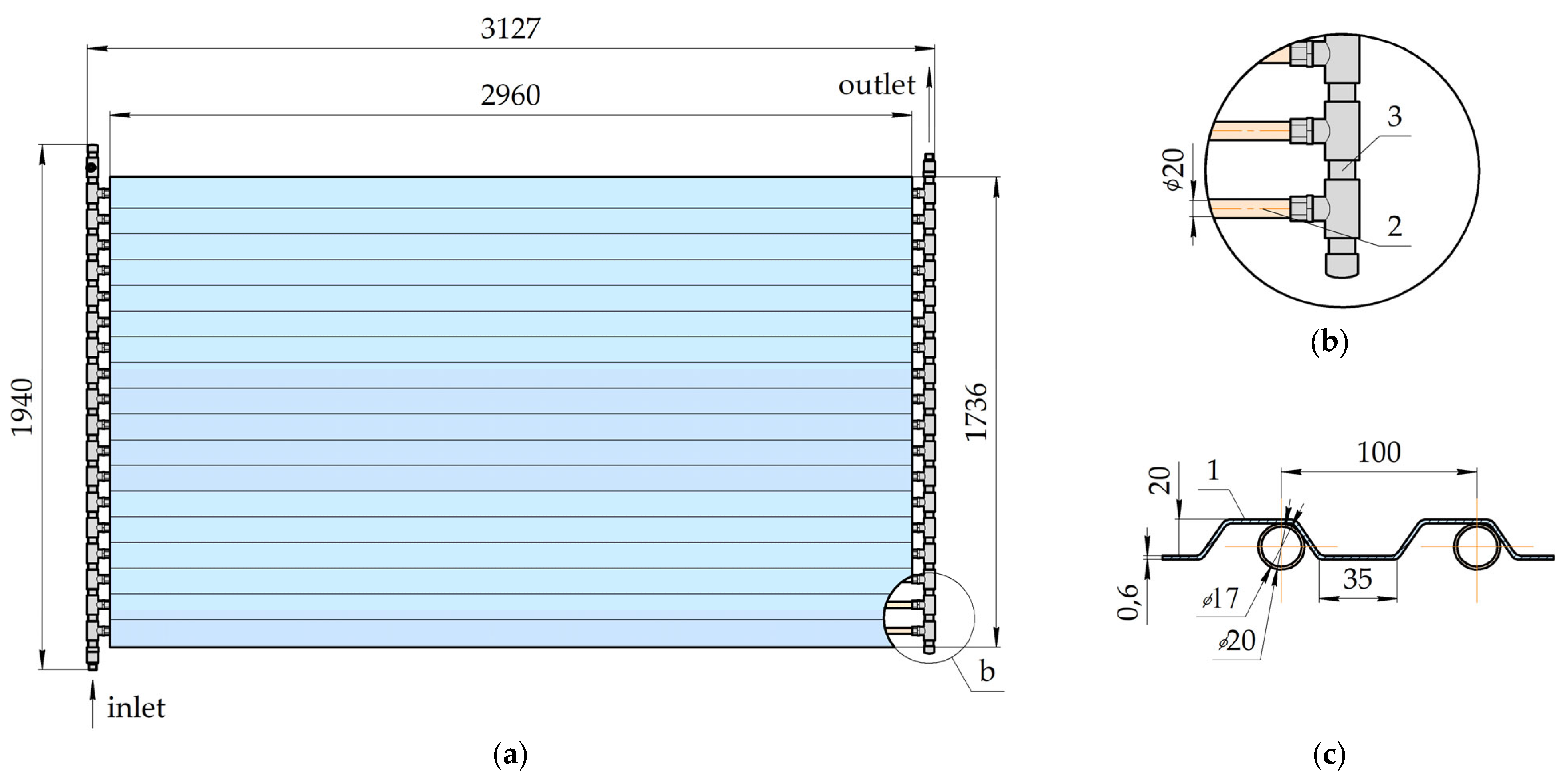

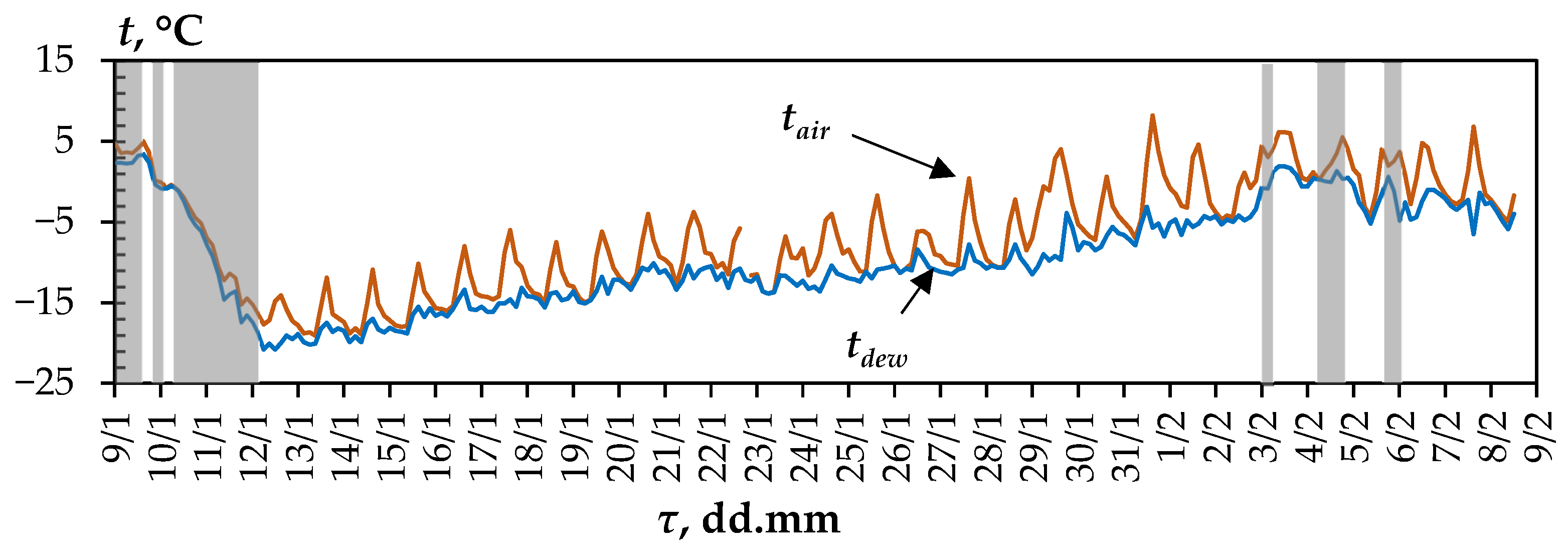
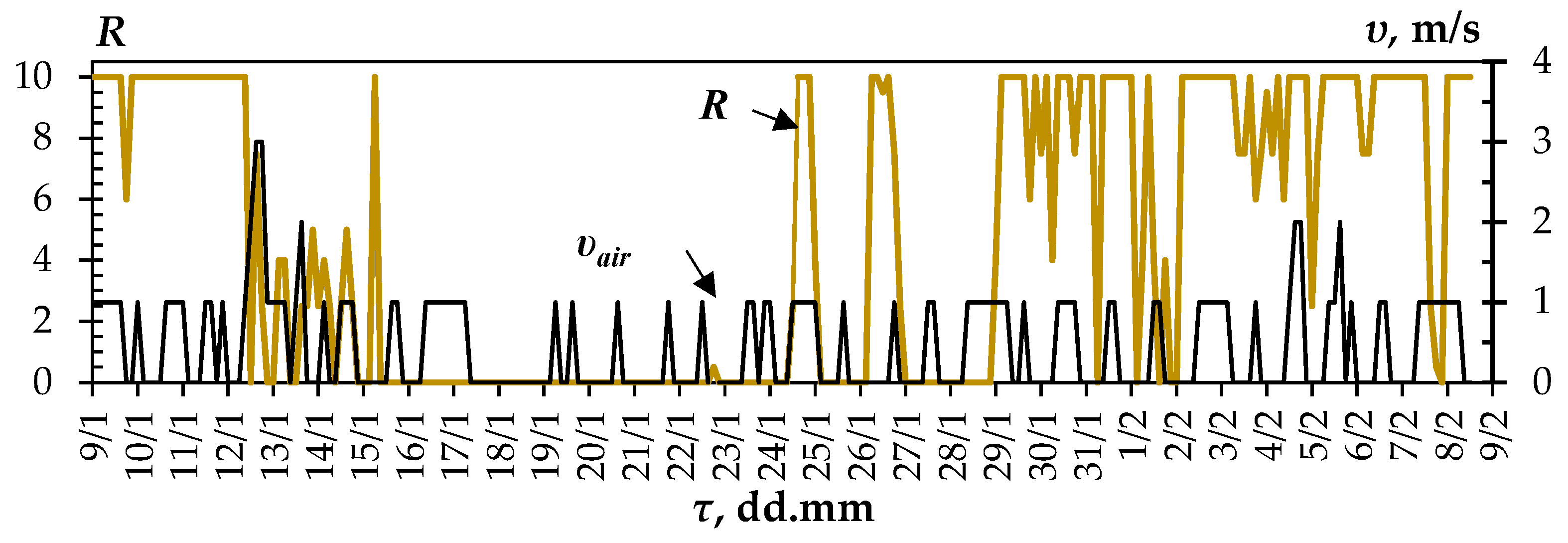
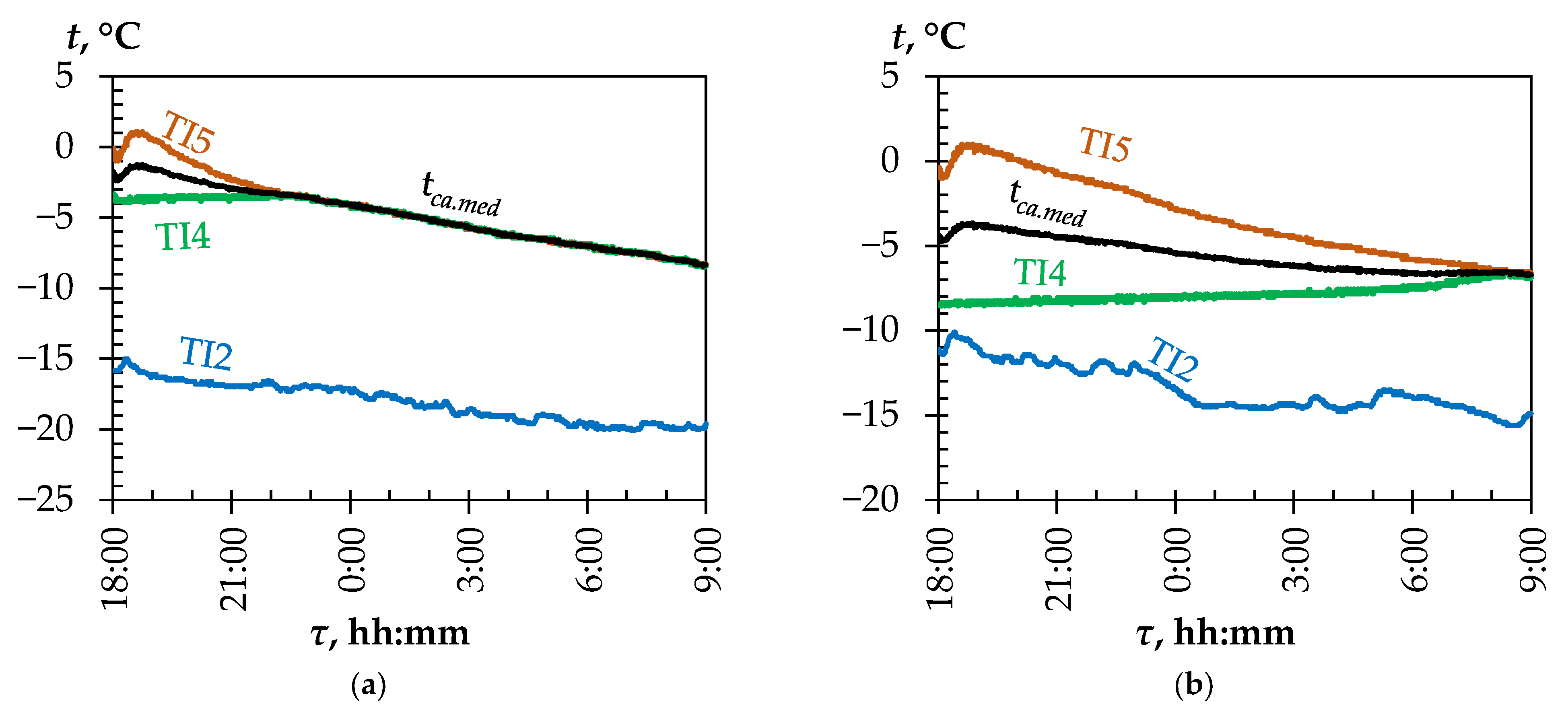
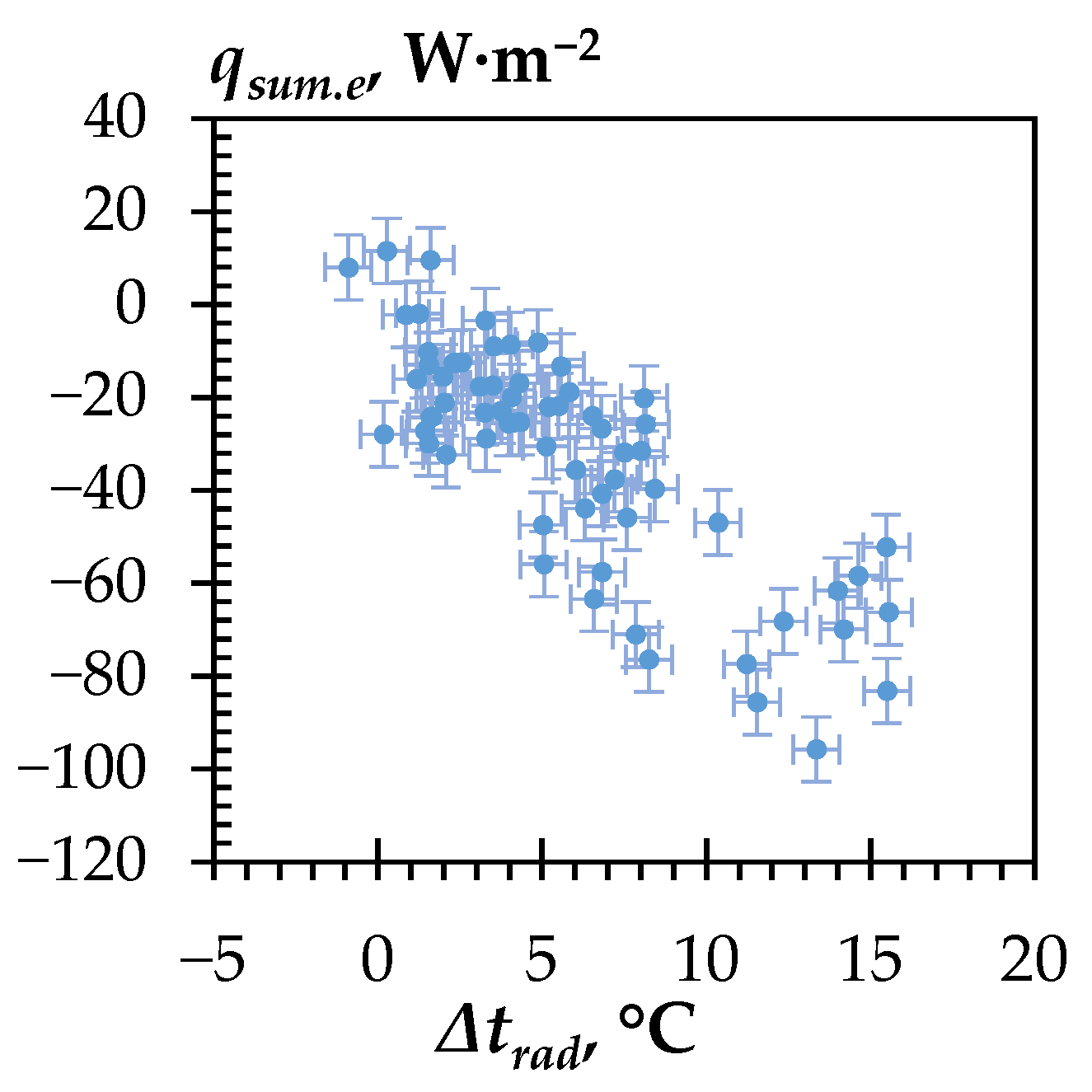

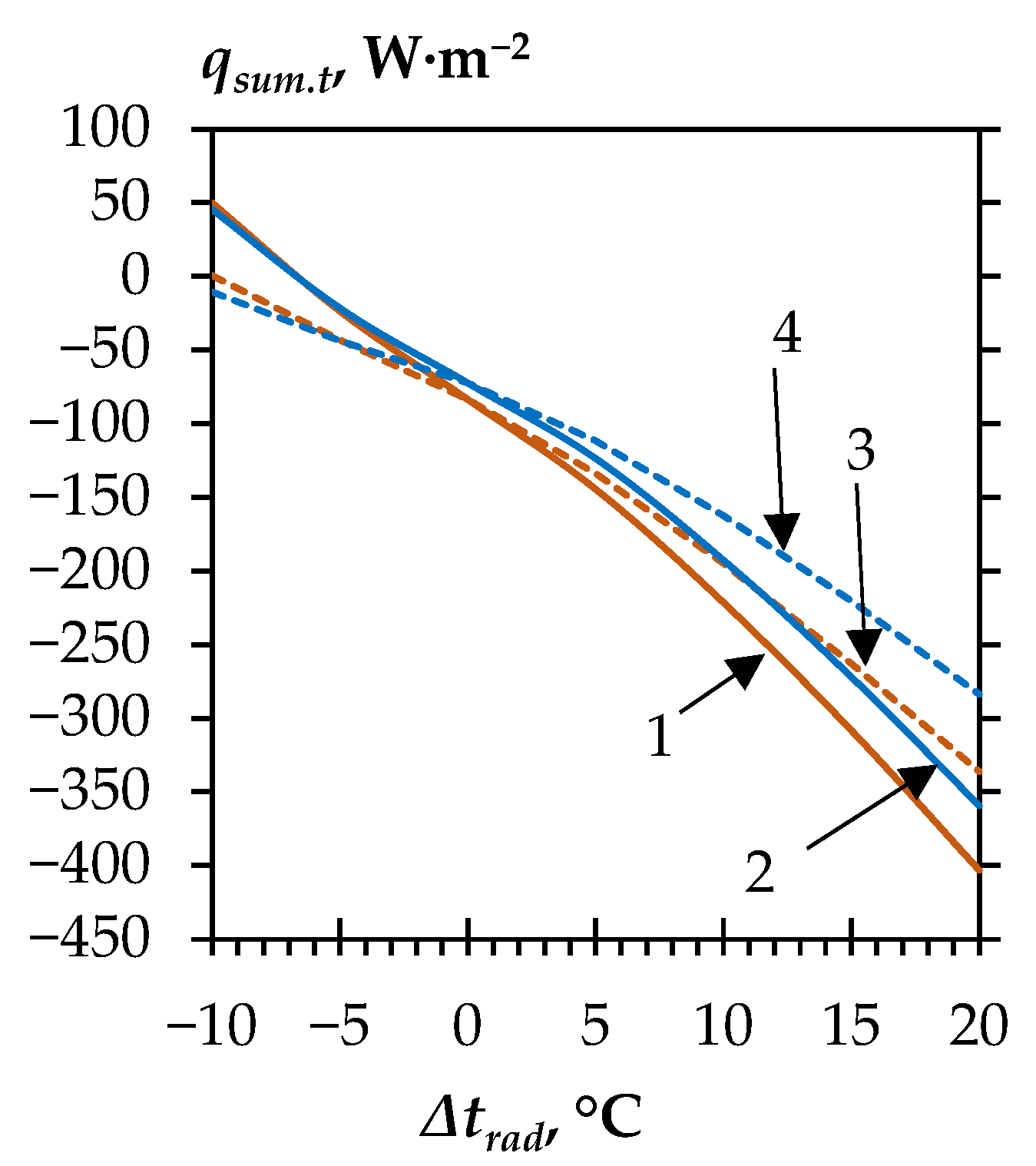
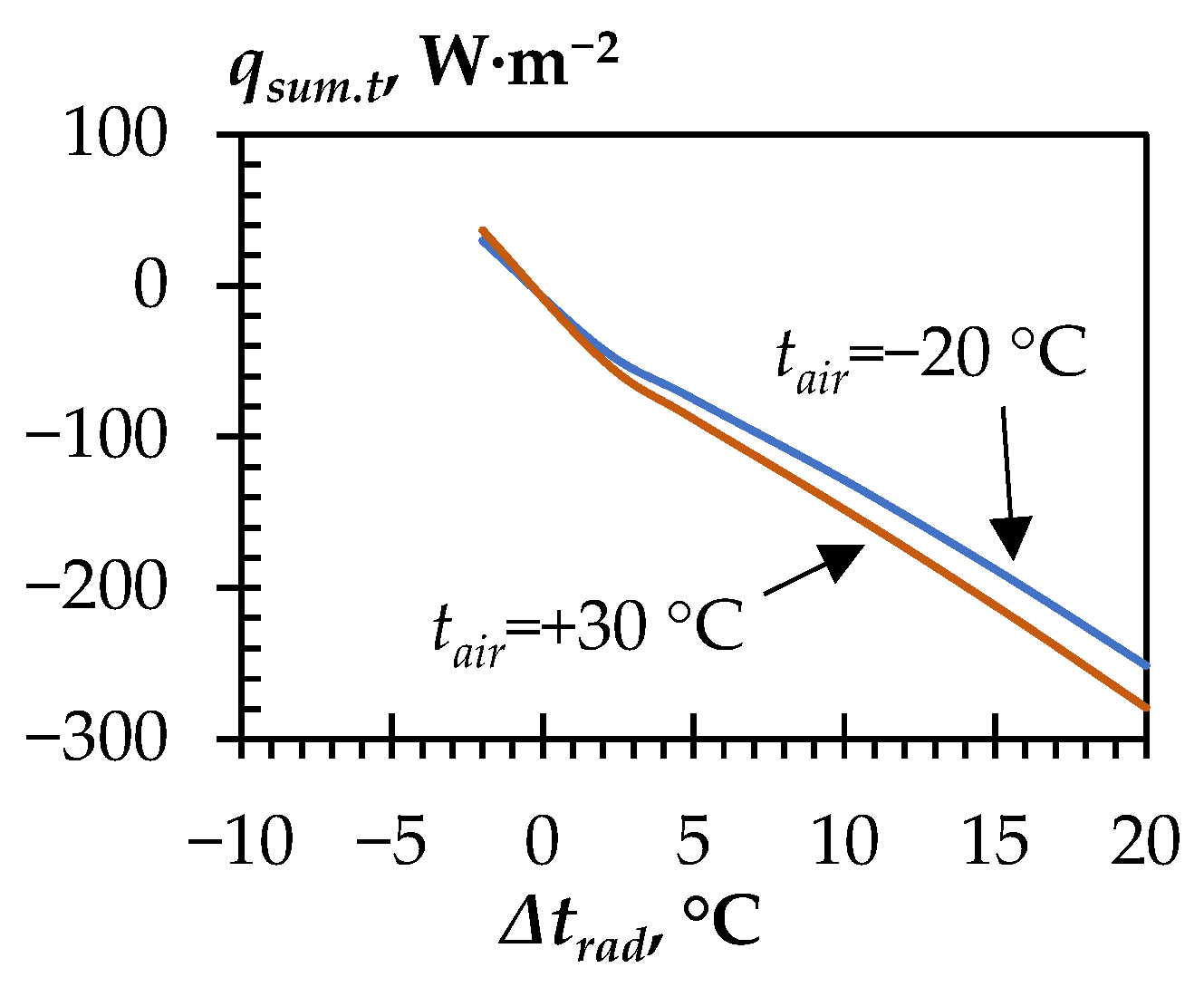

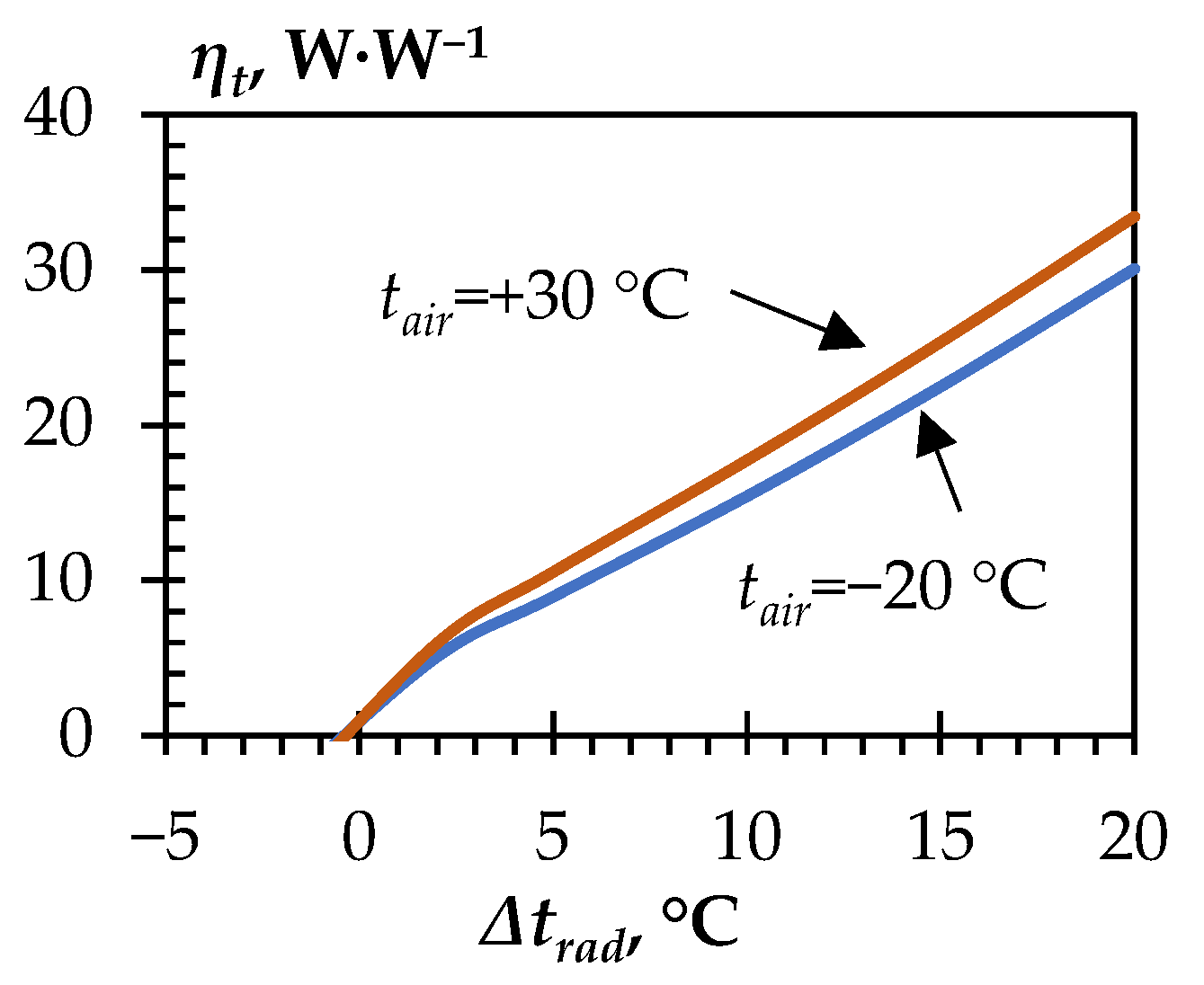
| Radiator | Cold Accumulator | ||
|---|---|---|---|
| Parameter | Value | Parameter | Value |
| Surface area, m2 | 5.14 | Form | cylindrical vertical |
| Material of radiating plate | steel 08 GOST 1050 | Model | KSC 40-203 |
| Radiating plate thickness, mm | 0.6 | Dimensions | |
| Sheet shape | C-21-1-000-06 GOST 24045-2016 | Diameter, mm | 1220 |
| Radiating surface coating | ZnO | Height, mm | 1620 |
| Pipes | Inner volume, m3 | 1.5 | |
| Number | 18 | ||
| Distance between pipe axes, mm | 100 | Thermal insulation | |
| Outer diameter, mm | 20 | Material | Mineral wool (Ursa GEO M-25F) |
| Wall thickness | 1.5 | Thermal insulation thickness, mm | 150 |
| Material | Aluminum AD1 GOST 4784-2019 | Thermal conductivity λD, W·m−1·K−1 | 0.034 |
| Heat transfer liquid | |||
| Material | aqueous solution of ethylene glycol | ||
| Mass concentration,% | 40 | ||
| Mass, kg | 900 ± 20 | ||
| Data | 18:00 | 21:00 | 0:00 | 03:00 | 06:00 | 09:00 |
|---|---|---|---|---|---|---|
| 09–10.01 | – | 1.70 | 1.35 | 0.95 | 0.90 | 0.80 |
| 10–11.01 | – | 2.90 | 1.60 | 1.60 | 0.80 | −0.70 |
| 11–12.01 | – | 1.35 | 0.15 | −0.80 | −2.30 | −3.35 |
| 12–13.01 | −1.75 | −3.00 | −4.10 | −5.80 | −7.00 | −8.35 |
| 17–18.01 | −4.50 | 4.45 | −5.40 | −6.15 | −6.65 | −6.70 |
| 18–19.01 | −5.65 | −6.20 | −6.55 | −7.20 | −7.80 | −8.20 |
| 19–20.01 | −6.95 | −7.05 | −7.30 | −7.35 | −7.65 | −8.00 |
| 23–24.01 | −8.00 | −7.70 | 7.60 | −7.70 | −8.10 | −8.40 |
| 24–25.01 | −6.95 | −6.85 | −7.15 | −7.30 | −7.25 | −7.55 |
| 25–26.01 | −6.00 | −6.15 | −6.45 | −6.65 | −6.85 | −7.05 |
| 26–27.01 | −5.65 | −5.90 | −6.10 | −6.15 | −6.20 | −6.55 |
| 01–02.02 | 6.25 | 5.20 | 4.00 | 3.50 | 4.05 | 3.83 |
| 02–03.02 | 5.00 | 4.55 | 4.10 | 3.75 | 4.10 | 4.40 |
| 06–07.02 | 4.75 | 4.40 | 3.65 | 3.35 | 3.10 | 2.95 |
| 07–08.02 | 5.60 | 4.70 | 4.00 | 4.45 | 4.15 | 3.50 |
| Data | 18:00–21:00 | 21:00–0:00 | 0:00–3:00 | 03:00–6:00 | 06:00–9:00 | |||||
|---|---|---|---|---|---|---|---|---|---|---|
| Δtrad | qsum.e | Δtrad | qsum.e | Δtrad | qsum.e | Δtrad | qsum.e | Δtrad | qsum.e | |
| 09–10.01 | − | − | 1.4 | −27.2 | 1.6 | −29.9 | 1.5 | −10.2 | 1.6 | −13.0 |
| 10–11.01 | − | − | 8.3 | −76.4 | 9.0 | −2.8 | 10.4 | −47.0 | 11.6 | −85.6 |
| 11–12.01 | − | − | 15.6 | −66.2 | 15.5 | −52.2 | 15.5 | −83.2 | 14.6 | −58.4 |
| 12–13.01 | 14.2 | −69.9 | 14.0 | −61.6 | 13.4 | −95.8 | 12.4 | −68.2 | 11.2 | −77.4 |
| 17–18.01 | 5.8 | −1.9 | 6.8 | −57.6 | 7.6 | −45.9 | 7.5 | −31.8 | 7.9 | −6.3 |
| 18–19.01 | 6.0 | −35.6 | 6.5 | −24.0 | 6.8 | −40.7 | 7.2 | −37.7 | 6.8 | −26.6 |
| 19–20.01 | 2.6 | −12.4 | 4.1 | −19.9 | 4.9 | −8.1 | 5.2 | −22.0 | 4.3 | −25.4 |
| 23–24.01 | 1.6 | 9.5 | 1.3 | −1.9 | 2.3 | −12.5 | 3.3 | −28.8 | 1.6 | −24.2 |
| 24–25.01 | 0.9 | −2.2 | 1.7 | −24.2 | 2.0 | −15.6 | 3.3 | −3.5 | 3.8 | −22.9 |
| 25–26.01 | 1.2 | −16.1 | 3.3 | −23.2 | 4.3 | −16.9 | 4.3 | −16.9 | 3.5 | −17.4 |
| 26–27.01 | 2.0 | −21.2 | 3.1 | 17.7 | 3.5 | −9.0 | 4.0 | −8.7 | 4.0 | −25.7 |
| 01–02.02 | 6.6 | −63.4 | 7.9 | −71.0 | 8.0 | −31.5 | − | − | 8.2 | −25.8 |
| 02–03.02 | 5.1 | −30.5 | 2.1 | −32.4 | 0.2 | −28.0 | 0.3 | 11.5 | −0.9 | 8.0 |
| 06–07.02 | 4.1 | −25.5 | 5.0 | −47.5 | 5.5 | −21.8 | 5.8 | −18.8 | 5.6 | −13.3 |
| 07–08.02 | 5.1 | −55.9 | 5.2 | −43.8 | − | − | 8.1 | −20.2 | 8.4 | −39.7 |
| Data | 18:00–21:00 | 21:00–0:00 | 0:00–3:00 | 03:00–6:00 | 06:00–9:00 |
|---|---|---|---|---|---|
| 09–10.01 | – | −10.0 | −10.8 | −10.6 | −10.8 |
| 10–11.01 | – | −50.4 | – | −63.3 | −70.3 |
| 11–12.01 | – | −94.9 | −94.3 | −94.7 | −89.2 |
| 12–13.01 | −88.5 | −87.6 | −85.6 | −76.6 | −69.6 |
| 17–18.01 | −44.6 | −48.9 | −48.1 | – | – |
| 18–19.01 | −39.7 | −42.3 | −44.0 | −46.2 | −43.8 |
| 19–20.01 | −18.7 | −27.9 | −31.8 | −34.4 | −29.4 |
| 23–24.01 | −12.5 | −9.8 | −17.1 | −23.0 | −12.5 |
| 24–25.01 | −6.8 | −12.4 | −14.5 | −23.1 | −26.0 |
| 25–26.01 | −9.6 | −23.0 | −29.3 | −28.6 | −22.7 |
| 26–27.01 | −14.6 | −21.6 | −24.7 | −27.4 | −27.4 |
| 01–02.02 | −43.7 | −51.2 | −51.0 | – | −49.5 |
| 02–03.02 | −2.4 | −13.8 | −1.1 | −1.9 | 6.4 |
| 06–07.02 | −25.8 | −31.3 | −34.1 | −36.0 | −34.8 |
| 07–08.02 | −33.9 | −41.8 | – | −52.3 | −54.3 |
Disclaimer/Publisher’s Note: The statements, opinions and data contained in all publications are solely those of the individual author(s) and contributor(s) and not of MDPI and/or the editor(s). MDPI and/or the editor(s) disclaim responsibility for any injury to people or property resulting from any ideas, methods, instructions or products referred to in the content. |
© 2023 by the authors. Licensee MDPI, Basel, Switzerland. This article is an open access article distributed under the terms and conditions of the Creative Commons Attribution (CC BY) license (https://creativecommons.org/licenses/by/4.0/).
Share and Cite
Tsoy, A.; Granovskiy, A.; Koretskiy, D.; Tsoy-Davis, D.; Veselskiy, N.; Alechshenko, M.; Minayev, A.; Kim, I.; Jamasheva, R. Experimental Study of the Heat Flow and Energy Consumption during Liquid Cooling Due to Radiative Heat Transfer in Winter. Energies 2023, 16, 4865. https://doi.org/10.3390/en16134865
Tsoy A, Granovskiy A, Koretskiy D, Tsoy-Davis D, Veselskiy N, Alechshenko M, Minayev A, Kim I, Jamasheva R. Experimental Study of the Heat Flow and Energy Consumption during Liquid Cooling Due to Radiative Heat Transfer in Winter. Energies. 2023; 16(13):4865. https://doi.org/10.3390/en16134865
Chicago/Turabian StyleTsoy, Alexandr, Alexandr Granovskiy, Dmitriy Koretskiy, Diana Tsoy-Davis, Nikita Veselskiy, Mikhail Alechshenko, Alexandr Minayev, Inara Kim, and Rita Jamasheva. 2023. "Experimental Study of the Heat Flow and Energy Consumption during Liquid Cooling Due to Radiative Heat Transfer in Winter" Energies 16, no. 13: 4865. https://doi.org/10.3390/en16134865









